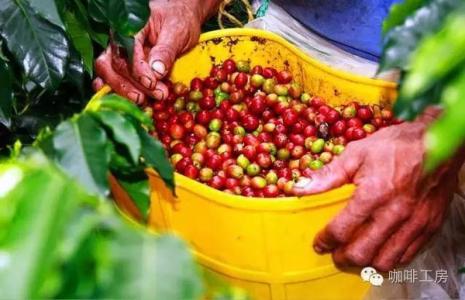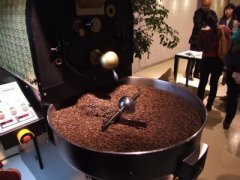Style Bright Costa Rican Yelsalo Fine Coffee Bean Flavor Taste Aroma Characteristics Description

Tarrazu in Costa Rican coffee is one of the major coffee producing areas in the world. The coffee produced has a light and pure flavor and pleasant aroma. Tarasu, located in the south of the country's capital, San Jos é, is one of the most valued coffee growers in the country. " La Minita Tarrazu coffee is a famous local product, but the production is limited, about 72600 kilograms a year. It is grown on a piece of land called "Lamini La Minita", which is owned by the last three generations of the McAlpine family in England. In fact, this land can produce more than 450 tons of coffee a year. Lamini coffee is grown without artificial fertilizers or pesticides, and harvesting and selection are done by hand to avoid some damage to coffee beans caused by air spray selection.
Drupe / micro-flower aroma, while the finish has a significant coffee flower aroma, is a taste of coffee full of Latin country style. Flavor: Brown sugar, floral aromas, almonds, black tea, oranges and sweet spices, mild acidity, syrup taste, good finish.
Other Costa Rican coffees worth mentioning are Juan Vinas,PR, H.Tournon, Windmill,SHB, Monte bello and Ssnta Rosa. Fine Costa Rican coffee is generally grown in Geredia and the central canyon. Another striking Costa Rican coffee is Sarchi (one of the five towns that represent Costa Rica's Coffee Road), which grows on the slopes of the Poas Volcano volcano, 53km from San Jose. Founded in 1949, Saatchi has a land area of 30770 hectares and grows sugar cane and coffee. The region is also famous for its handicrafts, attracting tourists from all over the world. Coffee was introduced to Costa Rica from Cuba in 1729. Today, its coffee industry is one of the well-organized industries in the world, producing up to 1700 kilograms per hectare. Costa Rica has only 3.5 million people but 400m coffee trees, and coffee exports account for 25 per cent of the country's total exports. Costa Rica's volcanic soil is very fertile and well drained, especially in the central plateau CentralPlateau, where the soil consists of successive layers of ash and dust. Costa Rica was therefore the first country in Central America to grow coffee and bananas for commercial value. Coffee and bananas are the country's main exports.
Costa Rica, with its fertile volcanic soil and good drainage, is the first country in Central America to grow coffee and bananas for commercial value. Coffee and bananas are the country's main exports. Coffee was introduced into Costa Rica from Cuba in 1729. Today, its coffee industry is one of the well-organized industries in the world, with a yield of 1700 kg per hectare. Costa Rica, with a population of only 3.5 million, has 400 million coffee trees, and coffee exports account for 25 per cent of the country's total exports. Costa Rica has also benefited from the establishment of the Central American Institute for Agricultural Research (TurrialbaoftheCentralAmericanAgriculturalResearchInstitute, referred to as IAAC) in Tarasu, which is an important international research centre.
High-quality Costa Rican coffee is called "extra hard beans". This kind of coffee can grow above 1500 meters above sea level. Altitude has always been a problem for coffee growers. The higher the altitude, the better the coffee beans, not only because the higher altitude can increase the acidity of the coffee beans and thus increase the flavor, but also because the night temperature at the higher altitude is lower, which can make the trees grow slowly, thus making the coffee beans have a stronger flavor. In addition, due to the high altitude drop caused by sufficient rainfall, is also very beneficial to the growth of coffee trees. However, while there are many advantages to growing coffee at higher elevations, the resulting additional transport costs must be taken into account, which is likely to make coffee production unprofitable. The coffee industry in Costa Rica has adopted new technologies to increase efficiency, including the use of "electric eyes" to select beans and identify coffee beans of irregular size.
Product name: Tarazhu Costa Rica Tarrazu SHB, Costa Rica
Country: Costa Rica
Producing area: Tarazhu Tarrazu
Manor: jaguar Manor El Puma Estate
Grade: SHB/EP
Treatment: washing and fermentation, drying in the back section.
Baking degree: medium baking
Finally, let's talk about personal taste. Using utensils: Philharmonic pressure, 20 seconds pressure filtration, 88 degrees water temperature, medium to medium fineness grinding, water powder ratio 12:1, this Philharmonic pressure product surprised me, no less than the successful siphon pot. The dry fragrance and wet fragrance are quite strong, and the dry fragrance of the powder is comparable to that of Yega Snow, to a sweet fragrance that makes people secrete saliva. It smells like chocolate. Rich aroma, mild taste, clean, can not taste astringent taste. The first mouthful was actively sour, but after a while the second bite felt very balanced and thick. After that, you will feel that the bright sour taste is blocked by glycol. After that, Huigan was also quickly and obviously, but it lasted not long. This cup is not bitter or astringent, the acidity is good, clean and mild Costa Rica, people who do not drink a single drink may like it.
The coffee produced in Costa Rica is light and sweet in flavor and pleasant in flavor. The excellent Costa Rican coffee is called SHB. The coffee beans here have been carefully processed, and that is why there is high-quality coffee. Costa Rican coffee is full of Arabica beans, washed with water, its style is bright, fragrant, clear as wind chimes swaying in the breeze, mild acidity and sweetness. Because of the sweetness, even if the coffee gets cold, it tastes very good. This is a major feature of Costa Rican coffee. Costa Rica is bordered by the Caribbean Sea to the east and the Pacific Ocean to the west, as the country's name means in Spanish: fertile shores. Located in the south of SanJos é, the capital of Tarasu, Costa Rica is one of the most valued coffee growers in the country. Tarasu (Tarrazu) is one of the major coffee producers in the world. Coffee farming is an extremely important industry in Costa Rican agriculture. The coffee beans produced at its high latitudes are famous in the world, with mild taste, high acidity, aroma and rich texture, so they are very popular. The raw beans are green and have large particles as a whole, all of which belong to Arabica species.
Costa Rica's coffee industry, originally controlled by the Costa Rican Coffee Industry Company (ICAFE), has been taken over by the official Coffee Committee (Oficinale Cafe). Among the exported coffee, those products that are considered to be of substandard quality are colored with blue vegetable dyes and then transferred back to China for sale. Coffee consumed domestically (dyed blue or undyed) accounts for about 10% of total production, and local per capita coffee consumption is twice that of Italy or the United States.
Brazilian coffee fruit, a coffee producer, accounts for 1/3 of the world's coffee consumption and occupies a place in the global coffee market, although Costa Rica faces several times more natural disasters than other regions. but its acreage is enough to make up for it.
There are many kinds of coffee here, but its industrial policy is large and cheap, so there is not much premium coffee, but it is a good choice for mixing other coffees. The newly developed villa sarchi planting, breeding and quality inspection research institutions, in addition, it also has 10 hectares of experimental plots, planting a number of excellent varieties. Coffee is Costa Rica's main agricultural product, with an annual output of more than 2 million bags (60 kilograms) and foreign exchange earnings of 250 million US dollars, second only to pineapples and bananas.
The coffee trees planted in Costa Rica are all Arabica coffee trees, and the quality of coffee beans is better and more stable through improvement. In order to facilitate picking, coffee trees are kept at a height of about 2 meters through continuous pruning. The coffee that people eat is the taste of the seeds in the fruit that are brewed in water. After picking raw coffee beans, the seeds (that is, coffee beans) can be roasted only by peeling, pulp, seed film and sun exposure. now part of the process can be replaced by machines, and the speed of coffee production has increased a lot. However, there is no machine to do the coffee picking, so we must use manual labor.
Tarrazu in Costa Rica is one of the major coffee producing areas in the world. The coffee produced is light and pure in flavor and pleasant in aroma.
The research center, located about 30 kilometers northeast of San Jose, the capital of Costa Rica, belongs to the Costa Rican Coffee Association and is a national coffee species in Costa Rica.
The newly developed villa sarchi planting, breeding and quality inspection research institutions, in addition, it also has 10 hectares of experimental plots, planting a number of excellent varieties. Coffee is Costa Rica's main agricultural product, with an annual output of more than 2 million bags (60 kilograms) and foreign exchange earnings of 250 million US dollars, second only to pineapples and bananas.
The coffee trees planted in Costa Rica are all Arabica coffee trees, and the quality of coffee beans is better and more stable through improvement. In order to facilitate picking, coffee trees are kept at a height of about 2 meters through continuous pruning. The coffee that people eat is the taste of the seeds in the fruit that are brewed in water. After picking raw coffee beans, the seeds (that is, coffee beans) can be roasted only by peeling, pulp, seed film and sun exposure. now part of the process can be replaced by machines, and the speed of coffee production has increased a lot. However, there is no machine to do the coffee picking, so we must use manual labor.
Costa Rican coffee has always been regarded as a perfect type of classic flavor, and balance, cleanliness and gentleness are his tone. This batch of Yerzaro treatment plant in the western valley region is famous for its excellent natural geographical conditions and excellent regional planting management techniques. the almost perfect classical flavor has a lively citrus flavor in the acidity, BlackBerry fruit aroma, acidity and taste, melons and sweet taste smooth taste.
Important Notice :
前街咖啡 FrontStreet Coffee has moved to new addredd:
FrontStreet Coffee Address: 315,Donghua East Road,GuangZhou
Tel:020 38364473
- Prev

The treatment method of grinding degree and baking degree of sweet, non-astringent, non-bitter and non-sour mai boutique coffee beans
Alishan Mafeel coffee is an authentic Taiwanese coffee. Mazu is taken from the language of the Zou people of the Alishan people, which means delicious. Alishan is the area where coffee is grown, while the Alishan coffee is grown by the Zou people, and it is also named Mafeel, and the coffee grown belongs to Taiwan coffee. Due to the low production of Taiwan coffee from Alishan.
- Next

Light and pure Costa Rican Yelsalo fine coffee beans Origin and development History and culture Introduction
Arabica coffee trees are grown in Costa Rica, and the quality of coffee beans is better and more stable through improvement; in order to facilitate picking, coffee trees are maintained at a height of about 2 meters through continuous pruning; people eat coffee because the seeds in the fruit are released by water infusion. After harvesting, green coffee beans must be removed from the skin, pulp, seed membrane and exposed to sunlight.
Related
- Detailed explanation of Jadeite planting Land in Panamanian Jadeite Manor introduction to the grading system of Jadeite competitive bidding, Red bid, Green bid and Rose Summer
- Story of Coffee planting in Brenka region of Costa Rica Stonehenge Manor anaerobic heavy honey treatment of flavor mouth
- What's on the barrel of Blue Mountain Coffee beans?
- Can American coffee also pull flowers? How to use hot American style to pull out a good-looking pattern?
- Can you make a cold extract with coffee beans? What is the right proportion for cold-extracted coffee formula?
- Indonesian PWN Gold Mandrine Coffee Origin Features Flavor How to Chong? Mandolin coffee is American.
- A brief introduction to the flavor characteristics of Brazilian yellow bourbon coffee beans
- What is the effect of different water quality on the flavor of cold-extracted coffee? What kind of water is best for brewing coffee?
- Why do you think of Rose Summer whenever you mention Panamanian coffee?
- Introduction to the characteristics of authentic blue mountain coffee bean producing areas? What is the CIB Coffee Authority in Jamaica?

